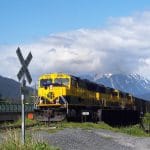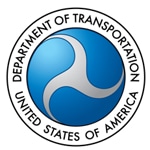At a nomination hearing September 17, 2015, before the Senate’s Committee on Commerce, Science, and Transportation, the Federal Railroad Administration’s (FRA) Acting Administrator Sarah Feinberg testified on her qualifications as Administrator. Below is her speech.
“Chairman Thune, Ranking Member Nelson, and Members of the Committee, thank you for the opportunity to appear before you today. Senator Manchin, thank you for your kind introduction. I am grateful for your friendship, your decades of service to our home state, and your strong support.
“I’ll just briefly note that I’m so pleased that my brothers, David and Matthew, are here with me, and other members of my family are with me in spirit.
“It is an honor to have been nominated by President Obama to serve as the Administrator for the Federal Railroad Administration and to have earned the confidence of Secretary Foxx. It is also a great responsibility, one that I take seriously.
“Just one month after I became Acting Administrator, a Metro-North train traveling out of New York City with hundreds of passengers hit a car at a grade-crossing. Six people were killed doing what millions of Americans do every day: traveling home from work; visiting friends; on the way to see family.
“Days later, in Senator Manchin’s and my home state of West Virginia, a mile-and-a-half long train carrying 109 tank cars loaded with crude oil derailed near the town of Montgomery. One person was injured; multiple small communities were evacuated; a fire burned for days. And anyone who visited the scene would agree: we got lucky.
“In May, an Amtrak train traveling significantly over the speed limit derailed in Philadelphia. The horrific accident took the lives of eight people—again, men and women simply closing out an evening commute and heading home to see their families.
“These accidents are searing reminders that millions of Americans depend on railroads, and FRA’s diligent oversight, to transport them safely to their jobs each morning, to their homes and families each night, and to deliver goods and products safely every day.
“Next year, FRA will be a half-century old. The agency has a proud history and a long list of accomplishments, most notably its significant contributions in recent years to improving rail safety. Rail deaths and injuries are down dramatically, worker injuries are down, derailments and incidents are down. And those decreases are very much a testament to the work of the men and women of FRA and the rail industry too.
“But, in many ways, safety in the rail industry has plateaued. Improvements are generally not as dramatic as they used to be, and we occasionally even see spikes in the wrong direction. That calls for action.
“The American people expect every federal agency to adapt to new conditions and new realities, to be willing to change, to be open to criticism. Over the last eight months, that is what FRA has done – willing to respond to new leadership, and a new direction. Along the way, we found new solutions to old challenges.
“We have tried new solutions to end the old challenge of grade crossings accidents and fatalities. We partnered with police around the country to step up enforcement. And, in June, Google agreed to integrate our grade crossing data to add audio and visual alerts on Google maps, marking the first time the agency has partnered with a technology company.
“We have taken a new approach to the way we handle old NTSB recommendations. When I arrived at FRA in January, there were more than 70 NTSB recommendations awaiting action. With new determination, we have taken action on more than half of them – reducing the number of outstanding recommendations by nearly 15 percent. Some of these recommendations had been sitting for at least five years. Today, we await word back from the NTSB on another 30. I will not be satisfied until each recommendation is acted upon, implemented, or at the very least responded to.
“We’ve also been looking for new solutions when it comes to our financing programs.
“FRA listened to the frustrations that many members of this committee expressed about the Railroad Rehabilitation & Improvement Financing (RRIF) program, and we’ve acted.
“With more staff and greater attention, we made the program stronger and faster. This year, we have already completed two and expect to complete two more soon. You have my word: the RRIF program is open for business.
“While working to try to bring new solutions to these old challenges, we’ve also stayed focused on our ongoing priorities. The men and women of FRA have spent much of 2015 delivering significant results on those priorities.
“With our sister agency, the Pipeline and Hazardous Materials Safety Administration, we completed the High Hazard Flammable Train rule. Since the crude oil train derailment in Lac-Mégantic, Canada, two years ago, the United States has seen more than a dozen crude oil train derailments of our own. In May, the Department of Transportation issued a final, comprehensive rule that aims to prevent these types of accidents—and lessens their impact if they do occur.
“We’ve prioritized PTC implementation – hiring staff and creating a task force that reports to me regularly on progress and the performance of each railroad. We were also proud to work with many here today and in the greater New York City region to provide a nearly $1 billion loan to implement Positive Train Control on MTA’s system.
“Both the Administration’s budget and its GROW AMERICA Act have requested significant funding to assist commuter railroads on PTC installation. Chairman Thune, I want to thank you and members of this committee, in particular, for the recently passed legislation that seeks to leverage $200 million to cover some of the costs and expenses railroads face when taking out a RRIF loan to implement PTC.
“All this activity is in addition to our continued focus on making sure the agency’s partners deliver High Speed Intercity Passenger Rail projects for the American people.
“We continue to closely monitor the funding that Congress invested across the country to provide faster, more frequent and more reliable passenger rail service.
“None of this success would have been possible without the tireless work of the nearly 900 public servants at the agency who are dedicated to rail safety. It’s been my honor to lead them as Acting Administrator.
“Chairman Thune and Ranking Member Nelson, I am pushing FRA each day to be vigilant in the pursuit of safety, and open to paths to innovation from any source. The agency is engaged, enthusiastic, and driven, because we know the gravity of our responsibilities and the size of our opportunities. A safe rail system is a strong rail system. And our country continues to need rail to build its future.
“If confirmed, I would eagerly work with all members of this committee and all members of Congress to build a stronger and safer rail system. One we can all be proud of.
“Thank you Mr. Chairman, and members of the Committee, and I look forward to your questions.”

 WASHINGTON – If left untreated, sleep apnea poses serious risks to anyone who sits behind the wheel of a commercial motor vehicle or climbs into the cab of a locomotive.
WASHINGTON – If left untreated, sleep apnea poses serious risks to anyone who sits behind the wheel of a commercial motor vehicle or climbs into the cab of a locomotive. WASHINGTON – U.S. Senator Lisa Murkowski responded to the news that the Alaska Railroad Corporation (ARRC) became the first railroad in the nation permitted to transport liquified natural gas (LNG) by rail, saying:
WASHINGTON – U.S. Senator Lisa Murkowski responded to the news that the Alaska Railroad Corporation (ARRC) became the first railroad in the nation permitted to transport liquified natural gas (LNG) by rail, saying: NEW ORLEANS – Federal Railroad Acting Administrator Sarah Feinberg and New Orleans Deputy Mayor and Chief Administrative Officer Andy Kopplin hosted the eighth of 11 nationwide regional forums on the Beyond Traffic draft framework at the New Orleans Regional Transit Authority Building. The Beyond Traffic report examines the trends and choices facing America’s transportation infrastructure over the next three decades, including a rapidly growing population, increasing freight volume, demographic shifts in rural and urban areas, and a transportation system facing more frequent extreme weather events. The report predicts increased gridlock nationwide unless changes are made in the near-term.
NEW ORLEANS – Federal Railroad Acting Administrator Sarah Feinberg and New Orleans Deputy Mayor and Chief Administrative Officer Andy Kopplin hosted the eighth of 11 nationwide regional forums on the Beyond Traffic draft framework at the New Orleans Regional Transit Authority Building. The Beyond Traffic report examines the trends and choices facing America’s transportation infrastructure over the next three decades, including a rapidly growing population, increasing freight volume, demographic shifts in rural and urban areas, and a transportation system facing more frequent extreme weather events. The report predicts increased gridlock nationwide unless changes are made in the near-term. Washington – The U.S. Department of Transportation (DOT)’s Federal Railroad Administration (FRA), the State of North Carolina and the Commonwealth of Virginia announced today that they have signed off on the Final Environmental Impact Statement (FEIS) for the proposed Richmond to Raleigh (R2R) passenger rail line along the Southeast Corridor. The completion of the FEIS is one of the final steps necessary before construction of the project can move forward once funding is secured.
Washington – The U.S. Department of Transportation (DOT)’s Federal Railroad Administration (FRA), the State of North Carolina and the Commonwealth of Virginia announced today that they have signed off on the Final Environmental Impact Statement (FEIS) for the proposed Richmond to Raleigh (R2R) passenger rail line along the Southeast Corridor. The completion of the FEIS is one of the final steps necessary before construction of the project can move forward once funding is secured.